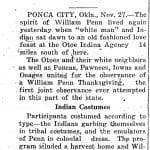Indians Hold Old William Penn Feast
November 27, 1925
The Daily Journal Capital
Microfilm Roll: MN00268
On this day in Osage country,
The Daily Journal-Capital published an article describing an event in which American Indians and whites came together to celebrate a mythical Thanksgiving.
According to the article, “the spirit of William Penn lived again” when a group of American Indians and whites came together for an “old fashioned love feast” which took place at the Otoe Indian Agency. Members of the Ponca, Pawnee, Iowa, and Osage tribes joined together for the occasion. The American Indian participants dressed in their tribal regalia while whites donned a “colonial dress.” Aside from a feast, the event also consisted of a pageant and an agricultural expo.
The irony of the situation, of course, is that the Indians and whites came together to celebrate the myth of Thanksgiving. According to Michele Tirado, in her article “The Wampanoag Side of the First Thanksgiving Story,” in the fall of 1621 the Pilgrims celebrated their first successful harvest with “tremendous amount[s] of gunfire.” Believing that perhaps this fire was aimed at his tribe, the Wampanoag Chief led nearly a hundred of his men to evaluate the situation. Most likely out of nervousness, the Pilgrims invited the American Indians to join their feast, but there was not enough food for everyone. The Chief then sent his men out to find more food, and they brought back several deer and presented them to the head of the Pilgrim town. The feast supposedly lasted for three days, but again was not held on a “friendly” basis.
The traditional thanksgiving holiday most Americans know began in 1863 not 1621. President Abraham Lincoln established the national holiday claiming that “in the midst of a civil war of unequalled magnitude and severity, the American people should take some time for gratitude,” (Waxman). However, this is not to say that Lincoln was the originator of the idea of Thanksgiving. Sarah Josepha Buell Hale, a writer and possible author of “Mary had a Little Lamb,” lobbied for the establishment of the holiday. Apparently, the publishing of Hale’s book
Norwood, in 1827, marked the beginning of her lobbying effort. It was in this book that Hale wrote, “We have too few holidays…Thanksgiving like the Fourth of July should be a national festival observed by all the people,” (Waxman). The Thanksgiving she most likely referred to was that established by George Washington in the late 1700s which was later decided by politicians to be a violation of the separation of church and state. Hale published later works consisting of poems, short stories, and recipes of which all had a Thanksgiving theme. She also lobbied by writing letters to politicians including Presidents Zachary Taylor and Lincoln. Although, Lincoln proclaimed Thanksgiving as a national holiday in 1863, the holiday was celebrated anytime between the months of September and December. Therefore, Hale continued her fight this time focusing on establishing the last Thursday in November as the official day of the holiday. Unfortunately, her grand effort did not pay off until after her death in 1879. It was not until 1941 that Congress passed a law making thanksgiving the fourth Thursday in November.
Morgan M. Guzman
“Indians Hold Old William Penn Feast.”
Daily Journal-Capital. November 27, 1925, p. 1. Microfilm roll number MN00268. Sequoyah National Research Center, Little Rock, Arkansas.
Further Reading
Tirado, Michelle. “The Wampanoag Side of the First Thanksgiving Story.”
Indian Country Today. https://indiancountrymedianetwork.com/news/the-wampanoag-side-of-the-first-thanksgiving-story/ Date accessed May 1, 2018.
Waxman, Olivia B. “Thanksgiving Wasn’t Always a National Holiday: This Woman Made it Happen.”
Time. http://time.com/4577082/thanksgiving-holiday-history-origins/ Date accessed May 1, 2018.
Source File(s)
Related Stories
Related Topics
View more stories in
Tags:

